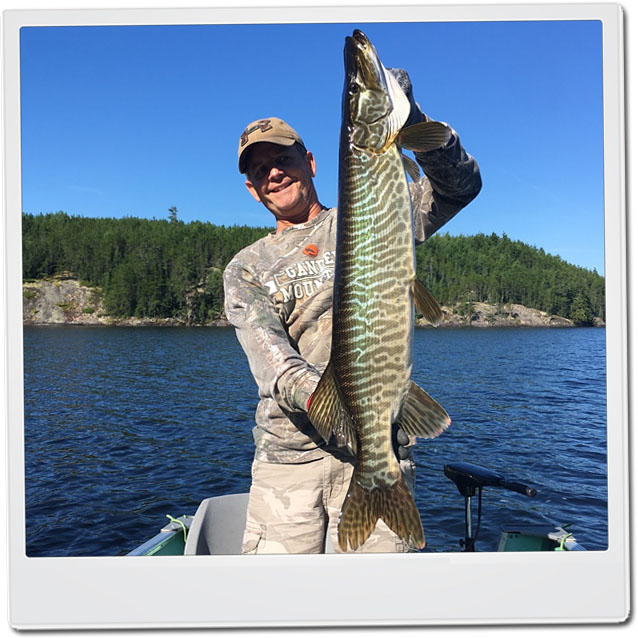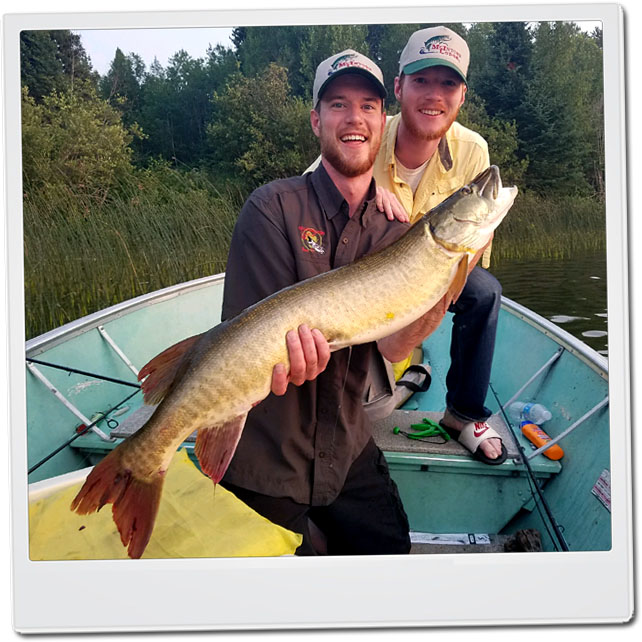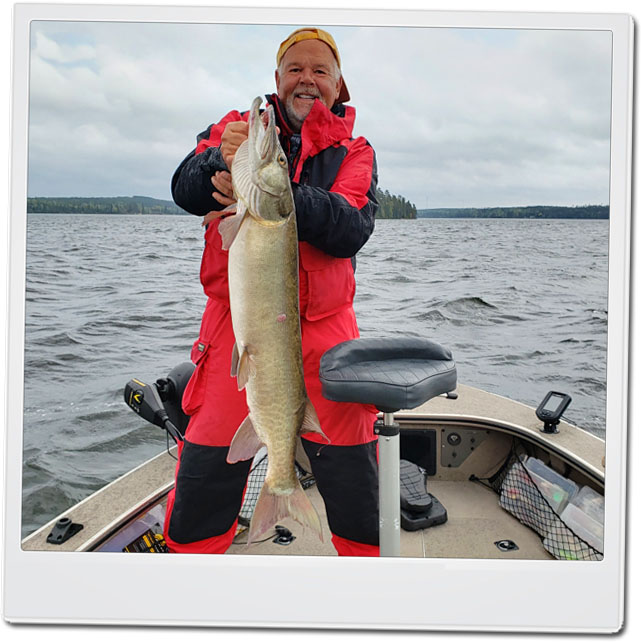




Favorite spots on the lake in the early summer or late spring are Outlet Bay, Powder Bay or any Bay where shallow warm waters are prevalent as well as walleye and perch. Some think that you should only fish weed beds in order to find Muskie, but that is not true on Canyon Lake. Down timber along the shore line are prime spots for early season Muskie. Fish the docks systems and abandoned docks along the shore line. Points off islands and shore lines, deeper break lines, sunken islands, humps, and reefs are also prime targets in summer and late summer.
There is common denominator in their pattern for late spring and early summer fish: they love to eat Perch and Walleye, as well as Smallmouth Bass, and love to have an ambush advantage. So, simply look for the other game fish and fish for Muskie where you find them! We have stories every season of clients who have encountered Muskie hanging on and t-boning nice walleye or smallmouth bass, and some have even landed Muskie every year on other game fish.
As the season progresses, and the weed beds start to brown and die, you will still find some smaller Muskie in the summer haunts. But, as the Walleye and Smallmouth Bass move into deeper basins and water, the larger Muskie will follow suit. You can tell a deepwater Muskie from a shallow-dwelling Muskie by the coloration of the fish. The deepwater fish will be large with a brownish back and little color, while the shallow fish will be smaller with bright markings. We have clear, barred, and some spotted or leopard Muskie. Our largest fish are caught during the fall, as they put on the feed bag for the upcoming winter. I know that trolling is a dirty word for some Muskie enthusiasts, but trolling a large crank bait over the top of schools of other game fish is really effective. By late fall sucker fishing is also very productive.

Top water is the most exciting way to fish early season, as well as summer, and there is a limitless supply of styles and sizes. My experience has shown that Perch, with the orange on the bottom side of your lure, works really well, since Perch are a favorite snack for our Muskie. Top water will work, even late in the season, if the water conditions are right. So, don't put them away just because you are in late summer.
Swim baits work well during the summer and late summer months as Muskie move to the reefs, humps, points and wind-swept shorelines. If you can get two or three days of wind from the same direction you can count on baitfish, game fish and Muskie stacking up. Use this to your advantage!
During the heat of the summer, plastics will work down deep, and there is an endless variety on the market. The only suggestion I would offer is to match you plastic with what swims in the lake. I have never encountered a Muskie that doesn't want a Perch or a Walleye. That little spot of Perch orange is always good to have in your lure selection.
In the fall, jerk baits can be very productive off islands that are near deep water. We don't pound the shore line, but keep your boat in 30 ft depths and cast your offering towards the shore, with a target range of 15-20 ft depths. This is also when the big cow girls and other big baits work on larger fish.
Trolling in the fall can be wild. I had a group of four fishermen who landed 72 Muskie in one week, trolling depth raiders over deep water on suspended fish. Fish over schools of Cisco, and troll over the top of those bait fish. Three miles per hour is the minimum I would suggest and go even faster to trigger a strike. This takes a good finder or graph, but it is worth the effort. Everyone has a favorite crank bait, but remember to have a Whitefish pattern, a Cisco pattern, and a Walleye pattern. Personally, I have caught more on Perch pattern than any other.

During any given week of Muskie fishing, you will have both great days and slow days. However, I will put Canyon Lake up against any other lake in our area when it comes to Muskie fishing. We have a great resource here on Canyon Lake, and I hope you will try it for yourself. I will offer one last piece of advice from my experience fishing Muskie: We all love to throw big baits, but I always have a #4 or #5 Mepps Spinner in bronze along in the boat. I have caught plenty of good sized Muskie on downsized baits. I believe that once you fish Canyon Lake for Muskie you will come back.
